As electronic technology advances, electronic components tend to become smaller and smaller. As the size of the components is reduced, so is the microscopic spacing and insulators and circuits within them, increasing the sensitivity to ESD. As you can see, the need of proper ESD protection increases everyday.






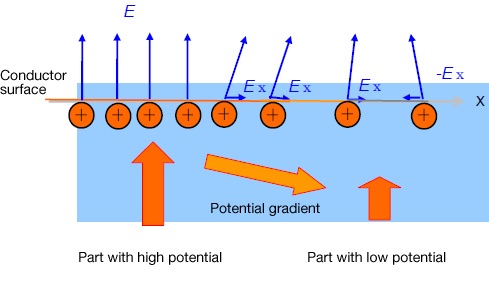
What is Static ?
How static is generate?
Static is generated when two objects made of different electrically neutral materials contact and then separate.
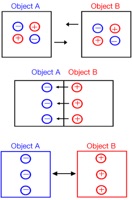
1) Contact between objects A and B
Electrically neutral objects A and B (with equal quantities of positive and negative charges)
2) Transfer of charge
When metals contact each other, electrons move from one with a smaller work function to one with a larger work function. In other words, metal with a smaller work function will be charged positively and one with a larger work function negatively.
3) Separation between objects A and B
Object A is charged negatively and object B positively.
Figure 1. Static generation due to contact charging
Static is generated when two objects contact and then separate. The combination of the two objects may be solid and solid, solid and liquid, or liquid and liquid. Figure 2 shows examples.

Figure 2. Examples of static generation
All the above phenomena involve contact between two objects and their separation.
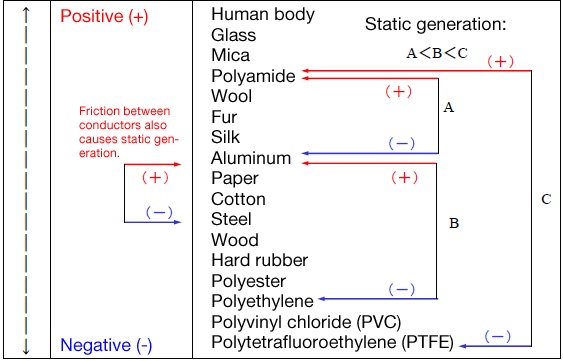
Figure 3. Examples of charging
Friction between two objects in a triboelectric series causes the object in the upper position of the series to be charged positively and that in the lower position to be charged negatively. Friction between two objects positioned far apart (C) also generates a larger amount of static than ones closer to each other (B) and much closer to each other (A) (A<B<C). It should also be noted that the triboelectric series includes conductors, and friction between conductors also generates static when they are insulated. As a result the conductors will be charged.
When an object is charged?
When an object is charged electrostatically, an electrical field is generated around the charged object, as illustrated in Figure 4.
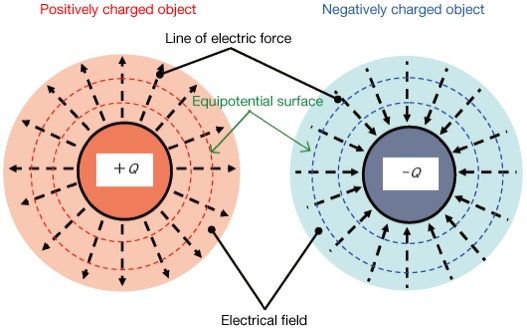
Figure 4. Electrical field generated around charged objects
An electrical field is a space in which an electric charge induces its electric force (Coulomb force) to work. An electrical field that does not change over time or spatially is called an electrostatic field. The number of lines of electric force that pass a unit area of a certain point (density of lines) indicates the strength of the electrical field, while the tangential direction of the lines of electric force on the point indicates the direction of the electrical field. The line of electric force also has the following characteristics.
-
1Starts from a positive electric charge and ends in a negative electric charge
-
2Lines do not intersect each other
-
3Does not branch off
-
4The electrical field is strong when lines of electric force are dense
-
5The electrical field is uniform when lines of electric force are parallel
-
6Comes out of (enters into) the surface of a conductor vertically
Figure 5 shows an example of lines of electric force formed between two charged objects.

(a) Lines of electric force between objects with different electrical polarities
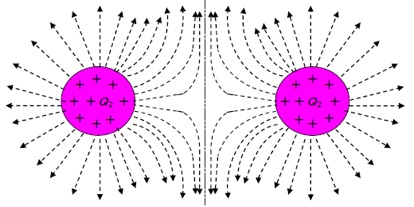
(b) Lines of electric force between objects with the same electrical polarity
Figure 5. Lines of electric force formed between two charged objects
Lines of electric force are virtual lines used to visualize an electrical field. Their use shows the state of an electrical field formed between two charged objects, making it easy to picture the state of static, which is actually invisible. For example, Figure 6 shows lines of electric force between two objects with different quantities of electric charge. It shows lines of electric force that apply to a case where the quantity of electric charge Q1 of charged object A is smaller than the quantity of electric charge Q2 of charged object B. Because the size of the two charged objects is the same, the number of lines of electric force per unit surface area of charged object A is smaller than that of charged object B, and electrical field E2 is stronger than E1.
E1: Strength of electrical field on a conductor surface
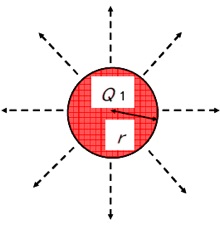
Density of lines of electric force: Low à Electrical field is weak
Charged conductive sphere A
E2: Strength of electrical field on a conductor surface
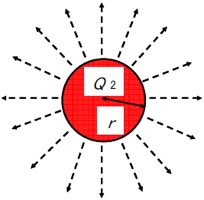
Density of lines of electric force: High à Electrical field is strong
Charged conductive sphere B
Figure 6. Lines of electric force from two charged conductors with different quantities of electric charge
What is electric force?
Electrostatic force (Coulomb force) is the source of an electrostatic phenomenon. As Figure 7 shows, the direction of the force between two charged objects differs according to whether the objects have different electrical polarities or the same electrical polarity. Electrostatic force is an attractive force (a) when the polarities are different and a repulsive force (b) when the two objects have the same electrical polarity.
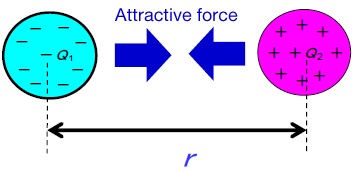
(a) Force between objects with different electrical polarities
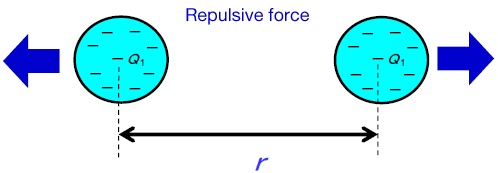
(b) Force between objects with the same electrical polarity
Figure 7. Electrostatic force between two charged objects
As Formula (1) shows, the strength of the electrostatic force (Coulomb force) is proportional to the product of the quantities of the electric charge of the two charged objects and inversely proportional to the square of the distance between the two objects.
F ∝Q1・Q2/r2 ・・・・・・・・・・・・(1)
Electrostatic induction is also caused by electrostatic force
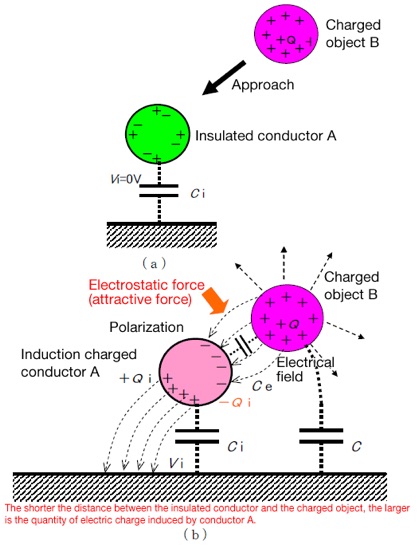
Figure 8. Electrostatic induction caused by electrostatic force
Electrostatic discharge is also caused by electrostatic force (Coulomb force)
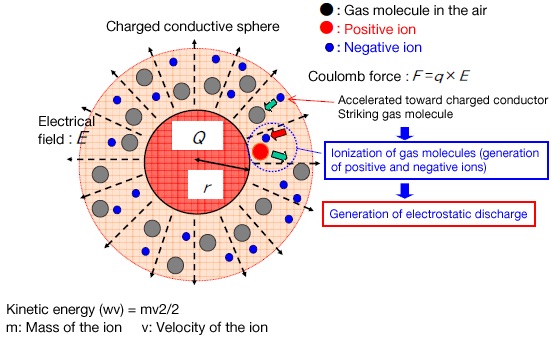
Figure 9. Generation of electrostatic discharge caused by electrostatic force
The electrical field around the charged object causes the negative ions (electrons) therein to be accelerated by the electrostatic force (Coulomb force), thereby having kinetic energy (wv). When these negative ions strike gas molecules in the electrical field and the following formula is true,
Ionization energy of the gas molecules < Kinetic energy (wv) of the negative ions (2)
electrons are sputtered from the gas molecules, resulting in generation of negative ions and positive ions. The gas molecules are ionized if the negative ions thus generated are subject to action of the electrostatic force and the negative ions are accelerated in the electrical field with its kinetic energy meeting the condition expressed in formula (2) above. Repetition of this process results in generation of electrostatic discharge.
Charge distribution of a conductor is also influenced by electrostatic force
1) Electric charges given to an electrically neutral conductor are distributed on the conductor’s surface. In other words, electric charges given do not exist inside the conductor. Suppose that a conductor is given four negative electric charges, thereby charged negatively, as Figure 10 shows. If the four charges are given inside conductor (a), electrostatic force (repulsive force) works among them, forcing them to be distributed on the conductor surface.
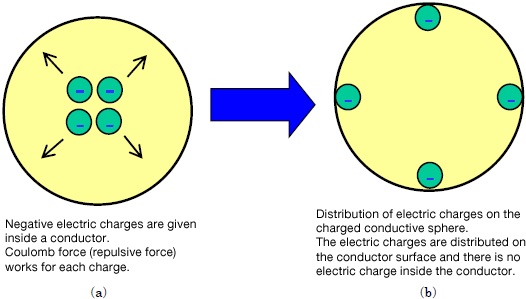
Figure 10. Distribution of electric charges on a charged conductive sphere
2) As explained in the previous section, electric charges given to an electrically neutral conductor are distributed on the conductor’s surface. These charges are distributed in a way that the surface will be equipotential. In other words, the charges given will not exist inside the conductor. Charges on a conductor are distributed in such a way that the surface will be equipotential.
(a) Conductor with surface potential distribution
If a conductor surface has potential distribution (a), a potential gradient (electrical field Ex) is generated along the surface. Ex causes the electric charges on the conductor surface to move along the surface to a part with low potential, thereby heightening the potential of the part. This movement of electric charges continues until the surface becomes equipotential.
As a result, the electrical field that comes out of (enters via) the surface of the conductor is vertical to the surface (b).

(b) Electric charges that are distributed in a way that makes the conductor surface equipotential
Figure 11. Electric charges are distributed on a conductor surface in a way that makes the surface equipotential.
Examples of problems caused by static
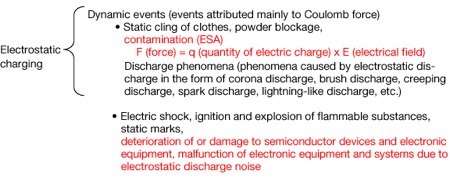
Figure 12. Examples of electrostatic problems
Ionizer principles
Basic countermeasures against static include grounding of metallic objects, grounding of workers and making the insulator conductive. Countermeasures against static to be applied for insulators that cannot be made conductive include inhibition of static generation by humidification and static elimination using an ionizer. However, it is difficult to completely prevent static generation from insulators by humidification. Excessive humidification may also accelerate deterioration of facilities or degrade product quality. Ionizers continue to produce an effect while not being so greatly affected by the environment, so they are applied in a wide variety of fields as an effective countermeasure against static in insulators.
Static eliminator (ionizer)
A voltage-applying static eliminator (ionizer) applies high voltage to the discharging electrode by using a high-voltage power supply. This causes generation of corona discharge between the discharging electrode and grounding electrode. The static eliminator (ionizer) ionizes the air by using the corona discharge, thereby generating positive and negative ions. Of the ions generated, those needed for static elimination (q) are moved to the charged object by Coulomb force (F) that acts in the direction of the object due to its electrolysis (E). This causes the charge on the object to be neutralized (static elimination).

Precautions for use of an ionizer
1) The static-elimination effect of an ionizer must be confirmed after its installation. The effect varies greatly depending on the installation distance, angle, air volume (applicable to fan-type ionizers), and air pressure (applicable to nozzle-type or gun-type units). There are two methods of confirming the effect. One is to measure the quantity of electric charge on the object after static elimination (by using a static meter or Coulomb meter). The other is to confirm the effectiveness of the ionizer itself by using a charge plate monitor
2) An ionizer needs regular maintenance. The discharging electrode needle generating ions and the area around it become dirty over time. This causes degradation of static elimination performance and loss of ion balance. The performance will be recovered when the discharging electrode needle and the area around it are cleaned. For a unit with a filter, air volume is reduced if the filter becomes dirty, so cleaning the filter is important.
3) The appropriate time for maintenance changes greatly depending on the usage environment. This time can be recognized through numerical management of ionizer performance with the charge plate monitor (NK-7001). A unit with a cleaning lamp also informs of when it requires maintenance.
To prevent static-related problems, countermeasures need to be taken by appropriately measuring static. Management of static measurements is also important for maintaining the efficacy of the counter measures. Kasuga Denki helps customers solve their static-related problems by offering a wide lineup of static measurement equipment, which ensures appropriate measurement and management for customers with varied needs. We also independently develop and produce static sensors, which are the heart of static measurement equipment. We continually strive to develop cutting-edge static measurement technologies.
Static measurement equipment
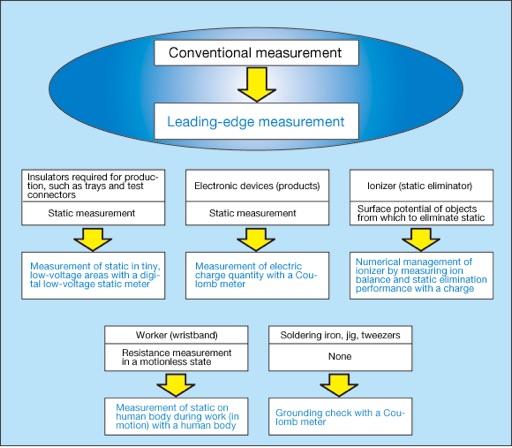
Static measurement in the electronics industry
Measurement principle of static meter
The figure to the left shows the measurement principle of the static sensor used for a static meter. The sensor utilizes electrostatic induction. When the detecting electrode receives the strength of the electrostatic field Eo (which is proportional to the charge potential Vo of the charged object) from the charged object, an induced charge q is generated. When this strength of electrostatic field Eo is changed periodically by using a vibrating electrode, the induced charge q also changes periodically. Displacement current Is resultantly flows from the detecting electrode to the grounding electrode. This current is converted into AC voltage signals Vs by the resistance Rs. The charge potential Vo of the charged object is found from these AC voltage signals Vs. This is how the static sensor works.
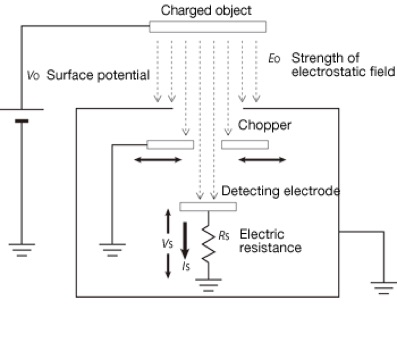
How to set up an ESD Protected Area (EPA)
Implementing ESD safe materials and products
should be performed according a specific logical ESD
strategy. Without these specific ESD procedures it has
little to no sense to install ESD safe products.
• Therefore we recommend to perform a pre audit
described in the ESD plan of approach, on the next
pages.
• This ESD plan of approach, must be based on recent
recordings of the company, an overview of the
measures to be taken in the field of protection against
static electricity, as well as the facilities have to be
taken in this context. A distinction is made between the
necessary, preferably directly implementing provisions
and recommended facilities that can be realized on
longer terms.

Commonly used terms:
ESD = Electro Static Discharge (ESD)
ESDS = Electro Static Discharge Sensitive (sensitive to static discharges)
EPA = ESD Protected Area (ESD-safe area)
Fc = Faraday cage
Pink Poly = plastic film products with a non-rechargeable (pink) coating (antistatic)
Shielding = packaging materials with a metallized (conductive) layer: These materials thus have a Faraday cage function.
ESD Protected Area (EPA)

Guidelines: How to set up an ESD Protected Area (EPA)



First it should be clearly defined which zones are EPA and which are not. Access to these areas can only be provided to those who are aware and comply with the preventive prescribed measures. This requirement applies to everyone, private operators, management, temporary employees, subcontract, maintenance personnel, visitors, ... Of general interest: correctly adjusting the relative humidity.
A. First step: drafting your ESD procedure:
B. Second step: general measures:
1. All areas where ESD safe work is being performed should preferably be marked as such; using special ESD warning shields or stickers and / or floor marking tape, the EPA’s can clearly be marked. Demarcation and defining the EPA (ESD Protected Area) all this to keep out and end off misunderstandings and unauthorized in these critical area(s) where ESD safe should be worked.
2. For controlling wrist strap, grounding cables, ESD shoes or heel grounders, it is necessary to provide and install a wrist-band/ shoe-test station, in a prominent place, preferably at the entrance to the EPA. Also the wristbands and grounding cables of the field service kits from any field staff can be checked here. It is recommended that the staff fill in each check, with date and initials, on the checklist hanging next to the tester.

2.a. Access control: before entering the EPA wristbands, grounding cables and footwear always should be checked. Possible access may or may not be linked to an ESD Access System.


3. Footwear: The same principle applies to us humans. We want to enter the EPA we need to check our ESD safe shoes The range is very extensive and we make a distinction between ESD safe and ESD-safe safety shoes. When working ESD safe, consistently checking is really required, this is why you have to check your footwear and wristbands daily before entering the EPA.

4. Wearing ESD clothing is strongly recommended so charges accumulated by motion, and therefore friction of our normal clothes, can be shielded from the sensitive components.

5. ESD safe Workbenches provided by BASS-ESD products. All of these tables are to be connected via a resistor of 1 MOhm coupled to ground/earth.

6. Grounding / grounding: The ESD standard IEC 61340-5-1/5-2 says that when one is performing his job sitting a wrist strap to ground always need to be worn. It is obvious that we also have to connect our workbenches and shelves to earth. We do this with grounding plugs and grounding cables (these are included in the table).

7. Tools: Certainly not unimportant because with this tool one comes closest to the ESD sensitive components, so it is strongly recommended to use ESD safe tools.

8. ESD Chairs: Here you have a wide choice from our collections that give us the assurance and guarantee that the seats are really ESD safe.

9. Trolley's: For transporting goods within the EPA, it is important they don't generate static charge caused by friction of the wheels.

10. All ESDS components and printed circuit boards should be stored throughout the company and transported in an ESD-safe packaging with Cage of Faraday function; this may be in the type of a static shielding bag or a container of conductive plastic. The shielding bags can be sealed with. ESD with special warning stickers.

11. Pink poly products, such as the rose packing bags and bubble foil, are not rechargeable (antistatic). These products however have not KvF function and are intended primarily as a non-rechargeable or disposable packaging for temporary use only used in the EPA. The anti-static coating in the plastic evaporated namely, under the influence of UV light, after a period of time, and loses its effect (the typical pink color is in this case becomes more pale).

12. The first and most important step in ESD safe working is to make sure that there are NO static materials in the EPA are present. The use of static rechargeable (packaging) materials, coffee cups, plastic folders, trash bags, etc., in an EPA should be avoided whenever possible.
13. To ensure an adequate internal control it is strongly recommended to provide the ESD coordinator within the company off a surface resistivity meter and an electrostatic field meter.


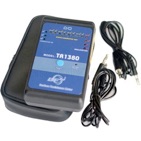
14. Floor: This is provided and should conform to EN / IEC 61340. In case of optimization at standing work ESD anti-stress mats can be offered. The maintenance of an ESD floor should be done with appropriate detergent aims to prevent the floor to become insulation by using ordinary cleaning agents.
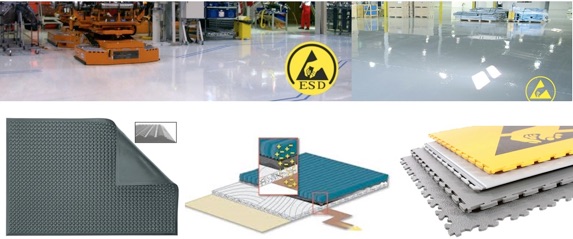
15. Warehousing and stock must be stored in proper packaging and custom carrying racks or cabinets. The packaging of ESD sensitive components must be done in the right packaging Pink bags do not protect against static charges and may only be used within the EPA. Sensitive components (without housing) which will transported outside the EPA should be put in Shielding bags or Moisture barrier bags (if they are susceptible to oxidation).

16. ESD Cleaning & maintenance: The installation of an ESD Protected Area (EPA) is very important and requires expertise. Even more important, and all too often overlooked, is the maintenance of these ESD protected areas. ESD conductive (dissipative surfaces), floor as well as table, should be treated with appropriate ESD-cleaners and cleaning utilities to assure these conductive properties are preserved. The use of ESD vacuum cleaners according the ESD Standards is of utmost importance not want to cause damage to ESD sensitive components within the EPA.

17. In addition taking the necessary ESD measures, it is important that all personnel, directly or indirectly, in contact with ESDS products is well aware of the phenomenon of ESD. B.A.S.S. ESD products provides special ESD courses and training which explains and shows the dangers of dealing with electrostatic charges, how you can recognize and protect ESDS devices getting damaged by ESD.
18. Ionization Many times, equipment or objects (insulators) are unable to be grounded in which case air ionizers should be used.

Electrostatic discharge is the rapid movement of a charge from one object to another object. As you walk across the carpet, you may not realize that you are generating several thousand volts of electrical charge that will cause severe damage to electronic components or entire circuit card assemblies. This shock, or release of energy, is what is known as Electrostatic Discharge or an ESD Event.
When your finger comes close to a door knob or your computer screen, you may feel a slight shock. Sometimes the results of an ESD Event will not show up for weeks or even months in electrical components. You may not realize it, but every time that you touch an electronic piece of equipment, you may feel nothing, but a sensitive electronic component could either be destroyed or become unstable.
What is electrostatic discharge (ESD)?
What cause ESD?
Static charges accumulate on the surface of conductors - the skin of a person, the surface of a conductive tote box, and an insulative surface - practically all plastics and textiles. Both conductors and insulators may become charged with static electricity.
These static charges "stay put". They cannot move because there is not path to ground. The charge is called "static" - not moving. A static charge will stay in place on the surface of an object until it has a chance to move. When a non-grounded conductor of static charges, a person or an object, comes close to a ground plane, the charge will "jump" from, a point on the non-grounded conductor to the grounded object, causing an ESD event. As you walk across the carpet and touch a metal door knob, the electrostatic charge that is built up on your body is discharged through the doorknob.
A charged object is surrounded by an electrostatic field. A charge from an electrostatically charged object can charge a component without actually touching the component. It may "jump" from the conductor to the electronic component from several feet away. This process is known as induction.
When a charged insulator comes close to a conductive object, the charge can be induced onto the conductor, which can then rapidly discharge to other conductors - an ESD event.
For Example: When plastic, an insulating material, is picked up, a large charge is created on its surface. The charge doesn't drain, even if the person is grounded. Insulative materials are more commonly understood to generate and hold static charge. Since they are insulators they do not allow the charge to move or distribute throughout the object. Insulators do not usually discharge to conductors except in rare high voltage situations. Grounding is not an effective method of neutralizing insulators. (We willdiscuss personal grounding and other methods of controlling ESD later in this course.).
With conductive materials such as metal, the static will be discharged from any grounded person picking up the metal. One common
misconception is that conductive materials do not generate charges. Ungrounded conductors can generate and hold static charges.
When a conductor is charged it can discharge rapidly when it comes close to another conductor with a different electrical potential.


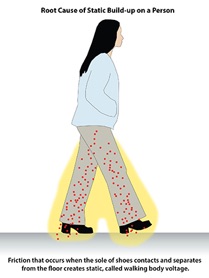

What types of materials can generate static electricity?
Almost any material can generate static electricity. The ability to store or dissipate the charge depends on the type of material.
Examples of Conductors at your Workstation
• Conductors can generate charges.
• Those charges can jump to ESD Sensitive components and assemblies.

Examples of Insulators at your Workstation
• Isulators hold charges.
• Those stored charges can be discharged to ESD Sensitive components and assemblies.

How much static does it take?
When you feel a static shock, you are feeling the generation of 3,000 volts of electricity.You will feel the electrostatic discharge of 3,000 volts, but smaller charges can damage electronic components, and you won't even be aware that a discharge has occurred. Some more sophisticated components can be damaged by charges as low as 10 volts. You should be aware of the relative sensitivity to ESD damage of the devices you may be working on/with.
Many of the your daily activities may generate charges from your body that are potentially harmful to components, such as:

Even moving objects on your workstation can generate hundreds of volts. The amount of static electricity also depends on the humidity of the environment. Low humidity conditions such as those created when air is heated in the winter will also promote the generation of significantly high voltages which can damage components.

Why should I care about ESD?
An ESD event causes a rapid electron movement through the microscopic conductive paths within a device and the heat spike resulting from this rapid charge will "melt" or cause damage to the electronic device.
If the discharge is large enough, the device will be destroyed and the defect will be found during device, component or board testing operations,prior to shipment to the customer. This is known as a catastrophic failure, the easiest type of ESD failure to identify. If you looked inside a component damaged in this way, you will see a microscopic meteor crater, a large hole blown in the surface of the part with scattered debris scattered around the damaged area.
If however, the discharge is not large enough to cause visible destruction, it might just weaken the part, diminishing the life of the assembly. This results in latent failure mode, where the component functioned normally during testing, but which can mysteriously fail during use in the customer's application. Latent failure is the most difficult failure to detect and is responsible for 90% of all failures. This is a very costly and reputation-sacrificing problem which can result in loss of business due to customer dissatisfaction.
The cost of ESD damage is not simply the cost of manufacturing the components, but includes the cost of component replacement, and the time cost associated with customer and field service. These damaged components become useless scrap. It is estimated that ESD damage cost American industry $5 billion dollars each year.
It is amazing when you look at the cost associated with ESD damaged components. The costs related to the failure depends on when the damage was discovered. It is estimated that if the damage is found:
• During assembly the cost is 1 times the cost of assembly and labor.
• During test the cost is 10 times the cost of assembly and labor.
• At the customer site the cost is 100 times the cost of assembly and labor


ESD Protected Areas
ESD-protected areas are recognizable by the signs or placards that are displayed before you enter the area. Sometimes these areas are marked off with yellow ESD tape on the floor.
These areas have implemented special ESD control procedures, which when followed provide for people to move around freely. Everyone and everything is grounded so static electricity is minimized. The total environment is controlled and those entering the area must adhere to ESD policies.
When handling ESD sensitive components or assemblies in a lab environment ESD policies and procedures must be followed.
In Engineering Labs special workstations are provided for ESD control. These workstations are grounded and stocked with all materials required to provide an ESD protective environment.
• Wearing foot straps and testing them before entering the protected area
• Conductive flooring
• ESD Policy
• Grounded work benches
• Mobile carts have conductive wheels and drag chains
• Conductive chairs
Control procedures include:
If Unneeded items are not brought in to the ESD protected area. Everyone who enters the area must abide by the rules for the protection to
be effective.
DO NOT enter these areas without proper understanding of the ESD control procedures implemented in the area.

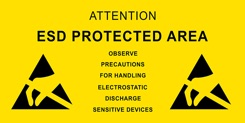
Work Area Control Techniques
Not all contact with electronic components takes place in an ESD controlled environment. Routers are upgraded, repairs are made, parts may be inspected by receiving and engineers must handle components. You may be handling components and assemblies at your work area or at your desk. ESD control techniques must be followed any time that you are handling electronic components.
As we discussed earlier in this program, when two objects separate, static builds up on their surfaces. You must control the build up of static on objects in your work area, yourself and the component or assemblies you are touching. These sensitive parts must be protected from charges around them.
To control and eliminate the effects of ESD:
• Remove unneeded static objects from your workstation - keep objects you need a safe distance away from sensitive components and assemblies.
• Use a topical antistatic, if possible, to eliminate static build up on objects that are necessary to do your job.
• Minimize movement and friction.
• Protect sensitive parts from the charges around them - Use ESD protective packaging.
• Place components and assemblies only on a dissipative mat or dissipative work surface.
• All personnel, surfaces and equipment must be grounded to drain off any charges that are created.
• Keep work surfaces clean and free of dirt build-up.
Some static generating objects are necessary to do your job, the best practice is to remove any unnecessary objects from you work area, but one way to control static is to keep objects a safe distance away from electronic components. ESD control containers are alsoa good way to store static generating objects.

Topical antistatic are a good way to minimize static build up on objects in your work area. Topical antistatic can be sprayed onto the surface of an object or the object can be dipped into the antistatic. The excess can then be wiped off with a
paper towel. Topical antistatic don't last forever and must be periodically reapplied. They are even less effective in areas of low humidity. The time varies between reapplication, so read the label and know how often to test the object and to reapply the antistatic.
Keep components and assemblies in their protective packaging until it is necessary to remove them from their protective packaging. When not working on ESD sensitive parts, or during transport or storage, keep the component in its approved packaging. This packaging includes pink poly, a static dissipative bag, static shielding bag or complete environmental barrier material. A component is not safe if it is laying on top of the ESD packaging.
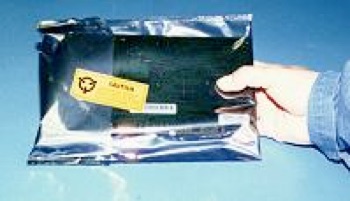
Here is an example of a common ESD-protective packaging:
Work on ESD sensitive parts only at an approved static-safe station, on a grounded static dissipative work surface. If you do not have a
dissipative work surface a dissipative mat should be used. Place your wrist strap snugly around your wrist and snap the wrist strap to the terminal on the mat. If you are working on a router, connect the mat to the unpainted surface on the chassis. (Do not wear a wrist strap around hazards w/ more than 250 volts and make sure that if you are working on a router that it is disconnected from power.)

Grounding
Grounding is important when handling electronic components. When you are grounded, you cannot build up static and damage electronic components. Grounding means that you have become electrically neutral.
When unprotected ESD sensitive devices are handled, you should work on an ESD protected workstation, an approved static-safe station, with a grounded static dissipative work surface.
Each person within twelve inches of unprotected ESD devices must be grounded.
(Grounding only neutralizes conductors.)
There are 2 types of grounding:
1. Resistive Ground
A resistive ground is a connection to ground through a wire and has a current limiting resistor. Resistance in the conductor is a property that opposes the flow of electricity through it. A resistor is used in a foot strap. A resistor in a foot strap will eliminate all static in a person within a fraction
of a second.
2.Common Point Ground
Common point ground is a terminal where people and ESD work surfaces can all be connected to ground. Two or more grounding conductors are connected to the same electrical potential. The person and work surface are connected to one common point ground, usually the building. You will typically find this type of grounding in manufacturing or assembly areas.
Storage, Packing and Handling
Electronic components have to be stored and moved from place to place. Regardless of the type of packaging you are using it has to be used correctly to protect ESD sensitive components. Components must always be put in protective packaging before being moved from an ESD protective area.

Shielding is used to prevent a sensitive device from being charged by exposure to ESD or being touched by a charged
object during transport or storage. A static bag must be sealed to protect it from damage from ESD. Electronic components can be damaged if they aren't packaged in ESD packaging. Components are not protected sitting on top of
packaging.
Components that are in ESD protective packaging can be stored and handled by people who are not grounded. When they are properly packaged they can be stored on any shelf. Components which are not in ESD protective packaging can only be handled by people who are grounded.
© 2020 by Koo Supply Shop. Proudly created with Jarundej Koosuwannakul
ESD Magazine Racks
Generator High Voltage Categories
Generator High Voltage Categories
Generator High Voltage Categories
Generator High Voltage Categories
Generator High Voltage Categories
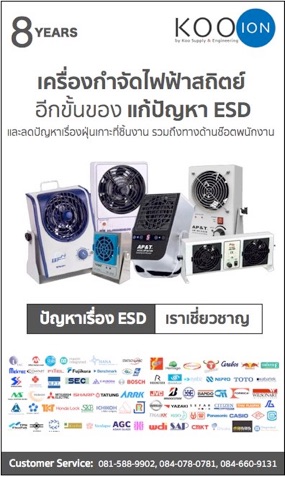

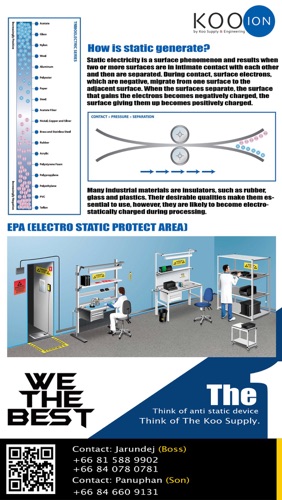

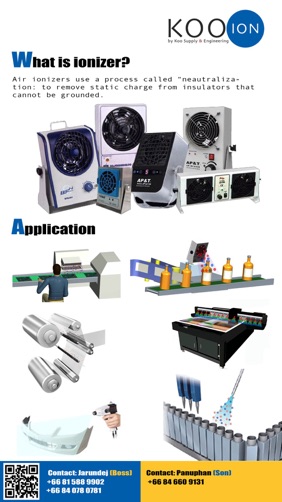



ESD Measurements
- Static Field Meter
- Surface Resistance Meter
- Mega Ohm Meter
- Charge Plate Meter
- Footwear & Shoe Tester
- Wrist Strap Tester
- Static Check Personal Meter
- Eliminate Human Body Antistatic Ball
- Wrist Strap Grounding Monitoring
- Grounding Real Time Monitor
- Calibration Grounding & Wrist Strap
Tools
- Automatic Label Dispenser
- Automatic Glue Dispenser
- Automatic Tape Dispenser
- Automatic Screw Dispenser
- Automatic Shoe Cover
- Lab Color Machine & Portable Color Meter
- Fume Purifying & Smoke Absorber
- Digital Torque Meter
- Gloss Meter
- Soldering Station & Soldering Pot
- Work Finisher & Heater Nippers
